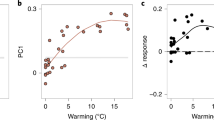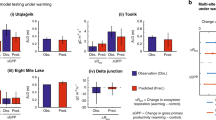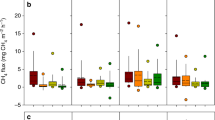Abstract
Plant growth often responds rapidly to experimentally simulated climate change1,2. Feedbacks can modulate the initial responses3, but these feedbacks are difficult to detect when they operate on long timescales4. We transplanted intact plant–soil mesocosms down an elevation gradient to expose them to a warmer climate and used collectors and interceptors to simulate changes in precipitation. Here, we show that warming initially increased aboveground net primary productivity in four grassland ecosystems, but the response diminished progressively over nine years. Warming altered the plant community, causing encroachment by species typical of warmer environments and loss of species from the native environment—trends associated with the declining response of plant productivity. Warming stimulated soil nitrogen turnover, which dampened but did not reverse the temporal decline in the productivity response. Warming also enhanced N losses, which may have weakened the expected biogeochemical feedback where warming stimulates N mineralization and plant growth1,5,6. Our results, describing the responses of four ecosystems to nearly a decade of simulated climate change, indicate that short-term experiments are insufficient to capture the temporal variability and trend of ecosystem responses to environmental change and their modulation through biogeochemical and ecological feedbacks.
This is a preview of subscription content, access via your institution
Access options
Subscribe to this journal
Receive 12 print issues and online access
$209.00 per year
only $17.42 per issue
Buy this article
- Purchase on Springer Link
- Instant access to full article PDF
Prices may be subject to local taxes which are calculated during checkout



Similar content being viewed by others
References
Rustad, L. E. et al. A meta-analysis of the response of soil respiration, net nitrogen mineralization, and aboveground plant growth to experimental ecosystem warming. Oecologia 126, 543–562 (2001).
Wu, Z., Dijkstra, P., Koch, G. W., Penuelas, J. & Hungate, B. A. Responses of terrestrial ecosystems to temperature and precipitation change: A meta-analysis of experimental manipulation. Glob. Change Biol. 17, 927–942 (2011).
Harte, J. & Shaw, R. Shifting dominance within a montane vegetation community: Results of a climate-warming experiment. Science 267, 876–880 (1995).
Smith, M. D., Knapp, A. K. & Collins, S. L. A framework for assessing ecosystem dynamics in response to chronic resource alterations induced by global change. Ecology 90, 3279–3289 (2009).
Melillo, J. M. et al. Soil warming, carbon–nitrogen interactions, and forest carbon budgets. Proc. Natl Acad. Sci. USA 108, 9508–9512 (2011).
Sokolov, A. P. et al. Consequences of considering carbon–nitrogen interactions on the feedbacks between climate and the terrestrial carbon cycle. J. Clim. 21, 3776–3796 (2008).
IPCC Climate Change 2007: The Physical Science Basis (eds Soloman, S. et. al) (Cambridge Univ. Press, 2007).
Leuzinger, S. et al. Do global change experiments overestimate impacts on terrestrial ecosystems? Trends Ecol. Evol. 26, 236–241 (2011).
Högberg, P., Fan, H., Quist, M., Binkley, D. & Tamm, C. O. Tree growth and soil acidification in response to 30 years of experimental nitrogen loading on boreal forest. Glob. Change Biol. 12, 489–499 (2006).
Kimball, B. A., Idso, S. B., Johnson, S. & Rillig, M. C. Seventeen years of carbon dioxide enrichment of sour orange trees: Final results. Glob. Change Biol. 13, 2171–2183 (2007).
Melillo, J. M. et al. Soil warming and carbon-cycle feedbacks to the climate system. Science 298, 2173–2176 (2002).
Penuelas, J. et al. Nonintrusive field experiments show different plant responses to warming and drought among sites, seasons, and species in a north–south European gradient. Ecosystems 7, 598–612 (2004).
Sebastia, M. Plant guilds drive biomass response to global warming and water availability in subalpine grassland. J. Appl. Ecol. 44, 158–167 (2007).
Zavaleta, E. S. et al. Grassland responses to three years of elevated temperature, CO2, precipitation, and N deposition. Ecol. Monogr. 73, 585–604 (2003).
Breshears, D. D. et al. Regional vegetation die-off in response to global-change-type drought. Proc. Natl Acad. Sci. USA 102, 15144–15148 (2005).
Overpeck, J. & Udall, B. Dry times ahead. Science 328, 1642–1643 (2010).
Knapp, A. K. & Smith, M. D. Variation among biomes in temporal dynamics of aboveground primary production. Science 291, 481–484 (2001).
Seager, R. et al. Model projections of an imminent transition to a more arid climate in southwestern North America. Science 316, 1181–1184 (2007).
Hartley, A. E., Neill, C., Melillo, J. M., Crabtree, R. & Bowles, F. P. Plant performance and soil nitrogen mineralization in response to simulated climate change in subarctic dwarf shrub heath. Oikos 86, 331–343 (1999).
Grogan, P. & Chapin, F. S. III Initial effects of experimental warming on above- and belowground components of net ecosystem CO2 exchange in arctic tundra. Oecologia 125, 512–520 (2000).
Kirschbaum, M. Will changes in soil organic carbon act as a positive or negative feedback on global warming? Biogeochemistry 48, 21–51 (2000).
Shaver, G. et al. Global warming and terrestrial ecosystems: A conceptual framework for analysis. Bioscience 50, 871–882 (2000).
Naeem, S., Hakansson, K., Lawton, J. H., Crawley, M. J. & Thompson, L. J. Biodiversity and plant productivity in a model assemblage of plant species. Oikos 76, 259–264 (1996).
Hector, A. et al. Plant diversity and productivity experiments in European grasslands. Science 286, 1123–1127 (1999).
Tilman, D. et al. Diversity and productivity in a long-term grassland experiment. Science 294, 843–845 (2001).
Chapin, F. S. et al. Consequences of changing biodiversity. Nature 405, 234–242 (2000).
Yang, H. et al. Community structure and composition in response to climate change in a temperate steppe. Glob. Change Biol. 17, 452–465 (2011).
Klanderud, K. & Totland, O. Simulated climate change altered dominance hierarchies and diversity of an alpine biodiversity hotspot. Ecology 86, 2047–2054 (2005).
Walther, G. Community and ecosystem responses to recent climate change. Phil. Trans. R. Soc. B 365, 2019–2024 (2010).
Luo, Y. et al. Progressive nitrogen limitation of ecosystem responses to rising atmospheric carbon dioxide. Bioscience 54, 731–739 (2004).
Thornton, P. E. et al. Carbon–nitrogen interactions regulate climate-carbon cycle feedbacks: Results from an atmosphere–ocean general circulation model. Biogeosciences 6, 2099–2120 (2009).
Christensen, J. H. et al. in IPCC Climate Change 2007: The Physical Science Basis (eds Solomon, S. et al.) 847–940 (Cambridge Univ. Press, 2007).
Burnham, K. P. & Anderson, D. R. Model Selection and Multimodel Inference: A Practical Information-Theoretic Approach (Springer, 2002).
Acknowledgements
The authors thank M. Allwright, D. Ross and N. Cobb for their assistance in the field, T. Ayers for plant identification, N. Umstattd, K-J. van Groenigen, R. Mau, J. Brown, R. Doucett, M. Caron and K. Wennig for their help in preparing and analysing plant and soil samples. We also thank B. Butterfield, S. Hart and D. Breshears for comments on data interpretation and earlier versions of the manuscript. This work was supported by the National Science Foundation (DEB-0092642 and DEB-0949460) and Science Foundation Arizona (GRF 0001-07).
Author information
Authors and Affiliations
Contributions
B.A.H. conceived the study. Z.W. and P.D. collected the data. Z.W. and B.A.H. analysed the data and drafted the paper. P.D. and G.W.K. helped with result interpretation and writing.
Corresponding author
Ethics declarations
Competing interests
The authors declare no competing financial interests.
Supplementary information
Rights and permissions
About this article
Cite this article
Wu, Z., Dijkstra, P., Koch, G. et al. Biogeochemical and ecological feedbacks in grassland responses to warming. Nature Clim Change 2, 458–461 (2012). https://doi.org/10.1038/nclimate1486
Received:
Accepted:
Published:
Issue Date:
DOI: https://doi.org/10.1038/nclimate1486
This article is cited by
-
Contrasting short-term vs. long-term effects of warming and nitrogen addition on soil organic matter density fractions in a temperate grass-dominated system
Plant and Soil (2023)
-
Seasonal effects of altered precipitation regimes on ecosystem-level CO2 fluxes and their drivers in a grassland from Eastern Australia
Plant and Soil (2021)
-
Early-spring soil warming partially offsets the enhancement of alpine grassland aboveground productivity induced by warmer growing seasons on the Qinghai-Tibetan Plateau
Plant and Soil (2018)
-
Modeling and improving Ethiopian pasture systems
International Journal of Biometeorology (2018)
-
The response of vegetation growth to shifts in trend of temperature in China
Journal of Geographical Sciences (2017)



